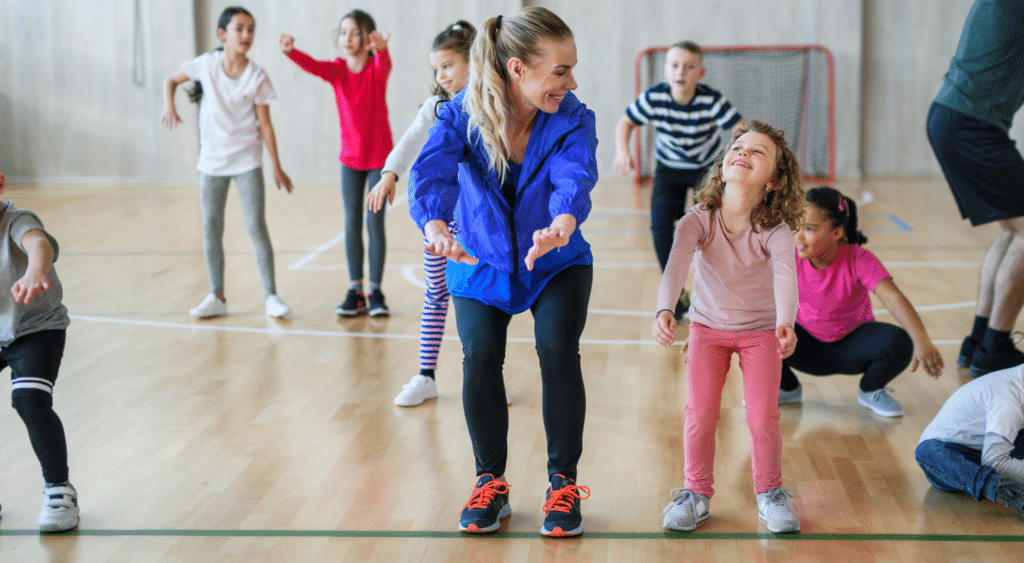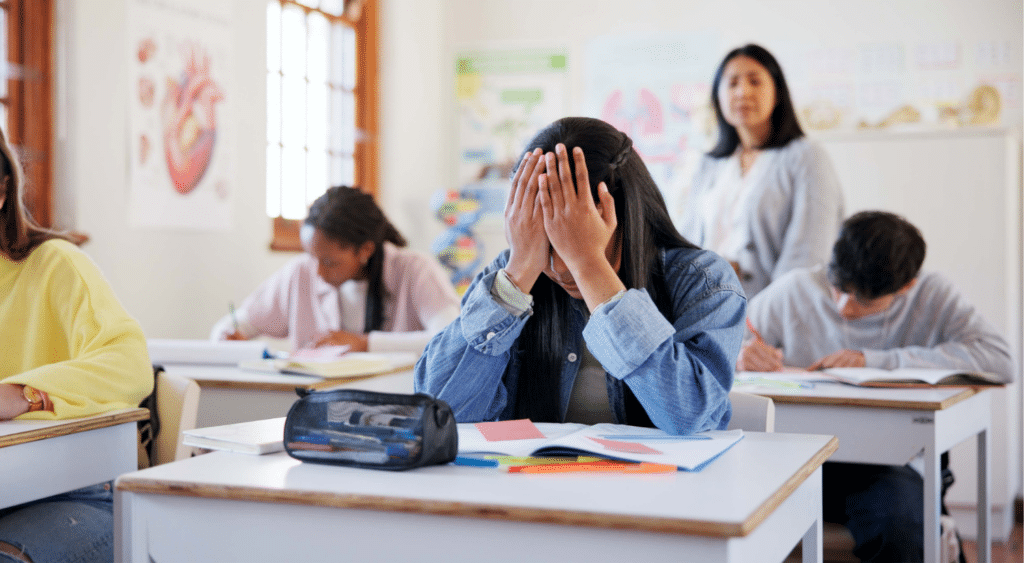Tips for a substitute gym teacher.

When you’re a substitute gym teacher, it’s a different ball game than a typical classroom. If you’re not a pro athlete, you might not feel like an exemplary specimen of physical fitness. No worries, you can do this!
Quick tips for substitute teaching a gym class.
- Wear comfortable clothing and shoes.
- Do not participate in the physical activity.
- Supervise the students.
- Safety comes first.
- Know where the nurse’s office is located.
Dress for success.
First, clearly — this isn’t a classroom with desks, books, and computers. So, as much as you like that cute skirt, mules, slacks and loafers, they won’t work this time. It’s best to wear clothing that is comfortable and appropriate for movement, along with a well-fitting pair of sneakers.
A tracksuit or athleisure outfit might be a good choice. Khakis can work if they’re comfortable and not too tight-fitting, paired with a T-shirt or polo shirt. Avoid jeans, sandals, and other open-toed shoes.
Remember that you may be asked to teach a regular class during the day. So, if your gym clothes aren’t classroom-appropriate, it’s a good idea to have some “business casual” clothes and shoes in your car, just in case.
Finally, something that isn’t clothing per se. but is important! Bring a whistle on a cord that you can hang around your neck. Trust us, it might come in handy!
Safety comes first.
Remember the old saying, “It’s all fun and games until someone gets hurt”? We hope no one ever gets hurt, but when kids are running, jumping, climbing, swinging bats, and throwing and kicking balls, well, there’s always the chance that something will happen.
- Ask about the school’s safety protocol.
- Know where the nurse’s office is.
- Be familiar with concussion protocol, CPR/AED, etc.
This information should be provided to you, but if it’s not, be sure to ask a school official before classes begin. You may also want to ask if there are any rules or restrictions on what the students can and can’t do. Remember, student safety is always your priority.
PRO TIP: It’s also good to find out the school or class cell phone policy. After all, there is a greater likelihood of phones being dropped and broken during sporting activities. More and more schools are restricting students’ phone usage during classes.
Since you’re not the regular teacher, students may try to take advantage of the situation, hoping you don’t know the rules. If there are restrictions, let everyone know at the start of class that nothing has changed, and you expect them to follow the rules.
Teaching gym class.
So what should you do in gym class? If the regular teacher left a plan, you’re all set. If not, here are some ideas…
Warm up.
This doesn’t necessarily mean toe touches or jumping jacks to get the blood moving. Take a few minutes at the start of class to talk to the students. Have them stand or sit quietly while you tell them what the plan is for that day. If you need to divide the class into teams, now is the time to do it. Also, take a minute or two to explain any specific rules or guidelines for the activity.
How long this “warm-up” will take depends on the ages of your students, the activity planned, and whether or not it’s something they’ve done before. Grade school and middle school kids tend to be more restless and anxious to play, so keep that in mind. In any case, remember that gym class is meant to get students moving and give them some time to play and exercise, so keep your warm-up talk as brief as possible.
Let the games begin.
Common gym class activities include dodgeball, kickball, softball, floor hockey, soccer, crab soccer, running, rope climbing, swimming, obstacle course, tennis, frisbee, frisbee golf, basketball, racing and relay racing, jump rope, and fitness stations. You’ll need to familiarize yourself with the rules.
Depending on the length of the gym period, consider two different activities, doing one for the first half and a completely different one for the second half. Or divide the class in two, with two activities at the same time. Then have the students switch to the other activity at the halfway point. Keep in mind that you need to continually monitor all students, so choose activities that allow you to do so.
Should you play, too?
You may be tempted to get in there and mix it up with the class—don’t do it. You’re not trained. Worse, if you’re not physically fit, you could end up with a bruise, sprain, or even worse. And if you’re huffing and puffing because you’re out of breath, it will be harder for you to maintain order. You’re there to monitor, keep things under control, and be the coach and/or referee if necessary.
Note that if you work for us at Kelly Education, it’s against our policy to participate. Why? Because of all the safety reasons mentioned above.
The goal of P.E. or gym class.
Yes, gym class allows students to run, play, and burn off energy. But remember, it’s much more than that.
- They learn about how their bodies work and gain confidence in what they can do.
- They develop skills such as coordination, hand-eye coordination, balance, and how to throw, kick and catch a ball.
- They even develop critical thinking skills as they consider different strategies or how to accomplish a certain task.
- They learn that practice leads to improvement, and they find out what they like and what they’re naturally good at.
- When playing team sports, they learn how to work with and rely on others, how to play their specific positions without taking over the game, how to engage in positive competition, and how to both win and lose.
- They learn about good sportsmanship, and they understand that they’re neither the best nor worst at anything.
These are good life lessons that will transfer to different areas as they grow older. As the substitute teacher, you should positively encourage the students in these lessons.
Cool down.
Be sure to save a few minutes at the end of class for your “cool down” talk. Have the kids all high-five each other for a job well done. Tell them what you observed, give them plenty of commendation and praise, and provide a little constructive criticism if needed. Emphasize a couple lessons mentioned in the previous paragraphs. This cool-down period also gives kids a chance to settle down, catch their breath, and get ready for their next class. (And you too!)
Alternatives to physical activity.
Okay, let’s face it: not everyone is athletically inclined, and you may know even less about sports than you do about microscopic life in the primeval Arctic Ocean.
If you feel like a fish out of water, speak to the school’s administration about doing a different activity that day. It should be something fun and less structured than a normal class. If you have a few ideas in mind, the administration may be more agreeable.
Become a substitute teacher with Kelly Education.
Remember, substitute teaching doesn’t always mean standing in front of a classroom, and substitute teacher duties often extend beyond the proverbial three R’s. Gym class provides students with a welcome break from the classroom, and the same can be true for you! It can be a unique and enjoyable means to interact with students in a completely different way.
If you’d like to become a substitute teacher, fill out our interest form and a Kelly Education recruiter will reach out to you. We’ll be happy to answer any questions, help you move forward with your goal, and let you know about substitute teacher jobs near you.

View Related: Article Workplace culture
You might like
Find your next job
Discover thousands of temporary, full-time, and remote jobs for beginning and experienced job seekers.


